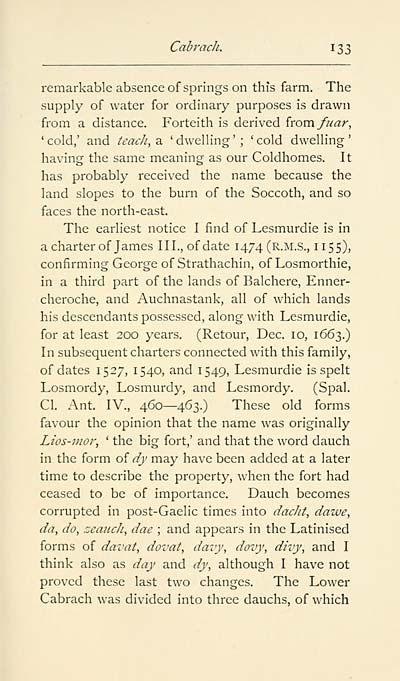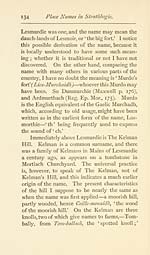Blair Collection > Place names in Strathbogie, with notes historical, antiquarian and descriptive
(157)
Download files
Complete book:
Individual page:
Thumbnail gallery: Grid view | List view

Cab rack. 133
remarkable absence of springs on this farm. The
supply of water for ordinary purposes is drawn
from a distance. Forteith is derived {rovafuar,
' cold,' and teach, a ' dwelling ' ; ' cold dwelling '
having the same meaning as our Coldhomes. It
has probably received the name because the
land slopes to the burn of the Soccoth, and so
faces the north-east.
The earliest notice I find of Lesmurdie is in
a charter of James III., of date 1474 (R.M.S., 1155),
confirming George of Strathachin, of Losmorthie,
in a third part of the lands of Balchere, Enner-
cheroche, and Auchnastank, all of which lands
his descendants possessed, along with Lesmurdie,
for at least 200 years. (Retour, Dec. 10, 1663.)
In subsequent charters connected with this family,
of dates 1527, 1540, and 1549, Lesmurdie is spelt
Losmordy, Losmurdy, and Lesmordy. (Spal.
CI. Ant. IV., 460—463.) These old forms
favour the opinion that the name was originally
Lios-mor, ' the big fort,' and that the word dauch
in the form of dy may have been added at a later
time to describe the property, when the fort had
ceased to be of importance. Dauch becomes
corrupted in post-Gaelic times into dacJit, dawe,
da, do, zeauch, dae ; and appears in the Latinised
forms of davat, dovat, davy, dozy, divy, and I
think also as day and dy, although I have not
proved these last two changes. The Lower
Cabrach was divided into three dauchs, of which
remarkable absence of springs on this farm. The
supply of water for ordinary purposes is drawn
from a distance. Forteith is derived {rovafuar,
' cold,' and teach, a ' dwelling ' ; ' cold dwelling '
having the same meaning as our Coldhomes. It
has probably received the name because the
land slopes to the burn of the Soccoth, and so
faces the north-east.
The earliest notice I find of Lesmurdie is in
a charter of James III., of date 1474 (R.M.S., 1155),
confirming George of Strathachin, of Losmorthie,
in a third part of the lands of Balchere, Enner-
cheroche, and Auchnastank, all of which lands
his descendants possessed, along with Lesmurdie,
for at least 200 years. (Retour, Dec. 10, 1663.)
In subsequent charters connected with this family,
of dates 1527, 1540, and 1549, Lesmurdie is spelt
Losmordy, Losmurdy, and Lesmordy. (Spal.
CI. Ant. IV., 460—463.) These old forms
favour the opinion that the name was originally
Lios-mor, ' the big fort,' and that the word dauch
in the form of dy may have been added at a later
time to describe the property, when the fort had
ceased to be of importance. Dauch becomes
corrupted in post-Gaelic times into dacJit, dawe,
da, do, zeauch, dae ; and appears in the Latinised
forms of davat, dovat, davy, dozy, divy, and I
think also as day and dy, although I have not
proved these last two changes. The Lower
Cabrach was divided into three dauchs, of which
Set display mode to: Large image | Transcription
Images and transcriptions on this page, including medium image downloads, may be used under the Creative Commons Attribution 4.0 International Licence unless otherwise stated. ![]()
| Early Gaelic Book Collections > Blair Collection > Place names in Strathbogie, with notes historical, antiquarian and descriptive > (157) |
|---|
| Permanent URL | https://digital.nls.uk/81168230 |
|---|
| Description | A selection of books from a collection of more than 500 titles, mostly on religious and literary topics. Also includes some material dealing with other Celtic languages and societies. Collection created towards the end of the 19th century by Lady Evelyn Stewart Murray. |
|---|
| Description | Selected items from five 'Special and Named Printed Collections'. Includes books in Gaelic and other Celtic languages, works about the Gaels, their languages, literature, culture and history. |
|---|

